
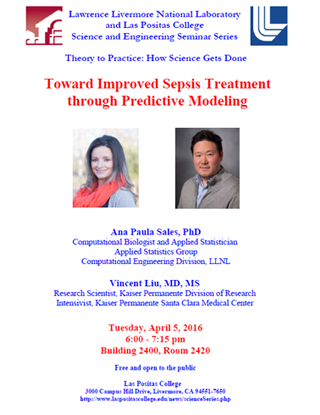
by
Ana Paula Sales, PhD
Computational Biologist and Applied Statistician Applied Statistics Group Computational Engineering Division, LLNL
Vincent Liu, MD, MS
Research Scientist, Kaiser Permanente Division of Research Intensivist, Kaiser Permanente Santa Clara Medical Center
Date: Tuesday, April 5, 2016
Time: 6 - 7:15 p.m.
Location: Room 2420 Lecture Hall, Building 2400, Las Positas College, Livermore, CA. [Directions and Campus Map]
No Cost: Free and Open to the Public
For More Information: Please contact: Nan Ho, Instructor of Biology, Las Positas College, at [email protected], Phone: 925.424.1344.
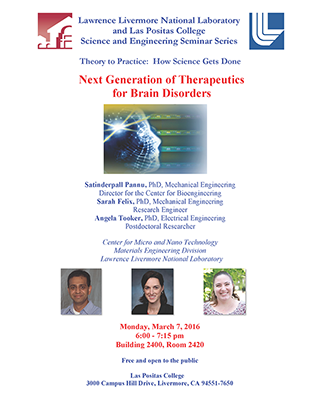
by
Satinderpall Pannu, PhD, Mechanical Engineering
Director for the Center for Bioengineering
Sarah Felix, PhD, Mechanical Engineering
Research Engineer
Angela Tooker, PhD, Electrical Engineering
Postdoctoral Researcher
Date: Monday, March 7, 2016
Time: 6 - 7:15 p.m.
Location: Room 2420 Lecture Hall, Building 2400, Las Positas College, Livermore, CA. [Directions and Campus Map]
No Cost: Free and Open to the Public
For More Information: Please contact: Nan Ho, Instructor of Biology, Las Positas College, at [email protected], Phone: 925.424.1344.
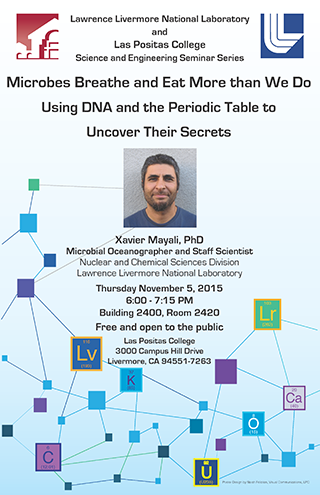
by
Xavier Mayali, PhD, Microbial Oceanographer and Staff Scientist
Nuclear and Chemical Sciences Division, LLNL
Date: Thursday, November 5, 2015
Time: 6-7:15 pm
Location: Room 2420 Lecture Hall, Building 2400, Las Positas College, Livermore, CA. [Directions and Campus Map]
No Cost: Free and Open to the Public
For More Information: Please contact: Nan Ho, Instructor of Biology, Las Positas College, at [email protected], Phone: 925.424.1344.
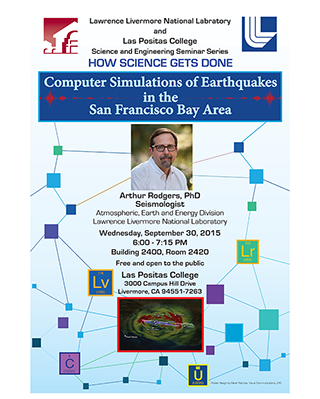
by
Arthur Rodgers, PhD, Seismologist
Atmospheric, Earth and Energy Division, LLNL
Seminar Abstract
Date: Wednesday, September 30, 2015
Time: 6-7:15 pm
Location: Room 2420 Lecture Hall, Building 2400, Las Positas College, Livermore, CA. [Directions and Campus Map]
No Cost: Free and Open to the Public
For More Information: Please contact: Nan Ho, Instructor of Biology, Las Positas College, at [email protected], Phone: 925.424.1344.
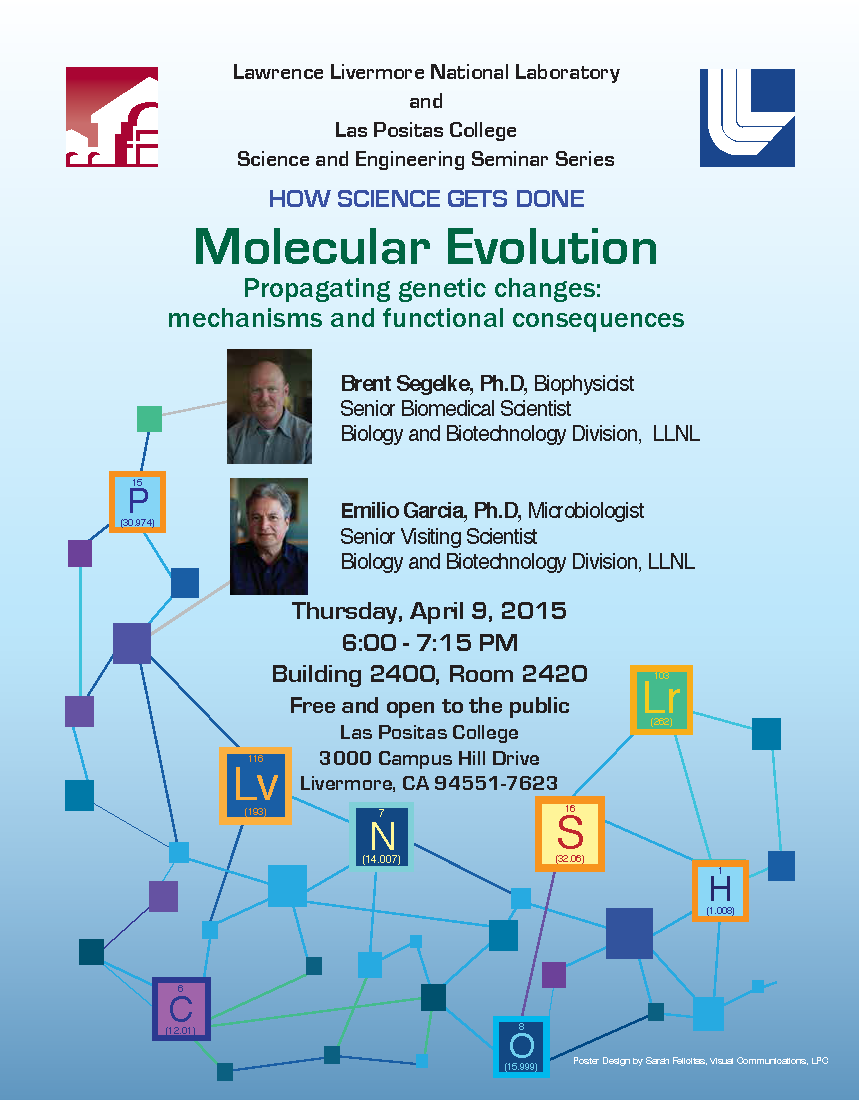
by
Brent Segelke, PhD, Biophysicist, Senior Biomedical Scientist Biology and Biotechnology Division, LLNL
and
Emilio Garcia, PhD, Microbiologist, Senior Visiting Scientist Biology and Biotechnology Division, LLNL
Date: Thursday, April 9, 2015
Time: 6-7:15 pm
Location: Room 2420 Lecture Hall, Building 2400, Las Positas College, Livermore, CA.
For More Information: Please contact: Nan Ho, Instructor of Biology, Las Positas College, at [email protected], Phone: 925.424.1344.
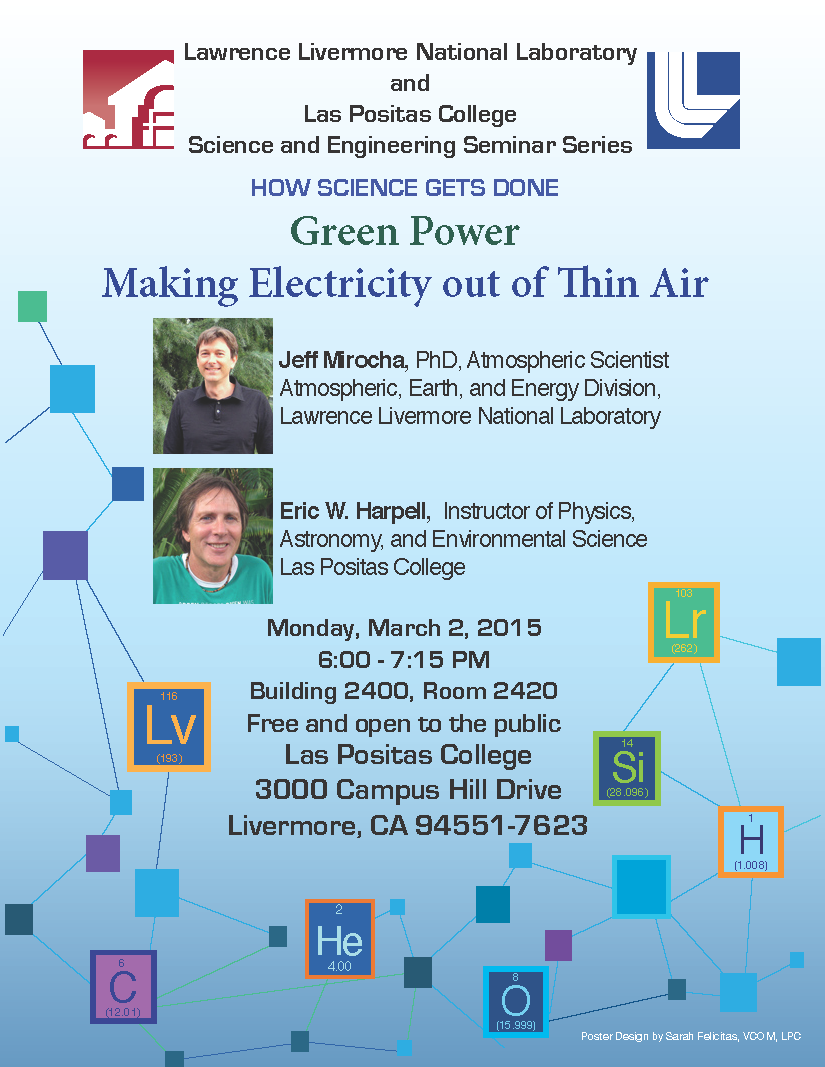
by
Jeff Mirocha, PhD, Atmospheric Scientist
Atmospheric, Earth and Energy Division, LLNL
and
Eric W. Harpell, Instructor of Physics, Astronomy, & Environmental Science Las Positas College
Date: Monday, March 2, 2015, 6-7:15 pm
Time: 6-7:15 pm
Location: Room 2420 Lecture Hall, Building 2400, Las Positas College, Livermore, CA.
For More Information: Please contact: Nan Ho, Instructor of Biology, Las Positas College, at [email protected], Phone: 925.424.1344.
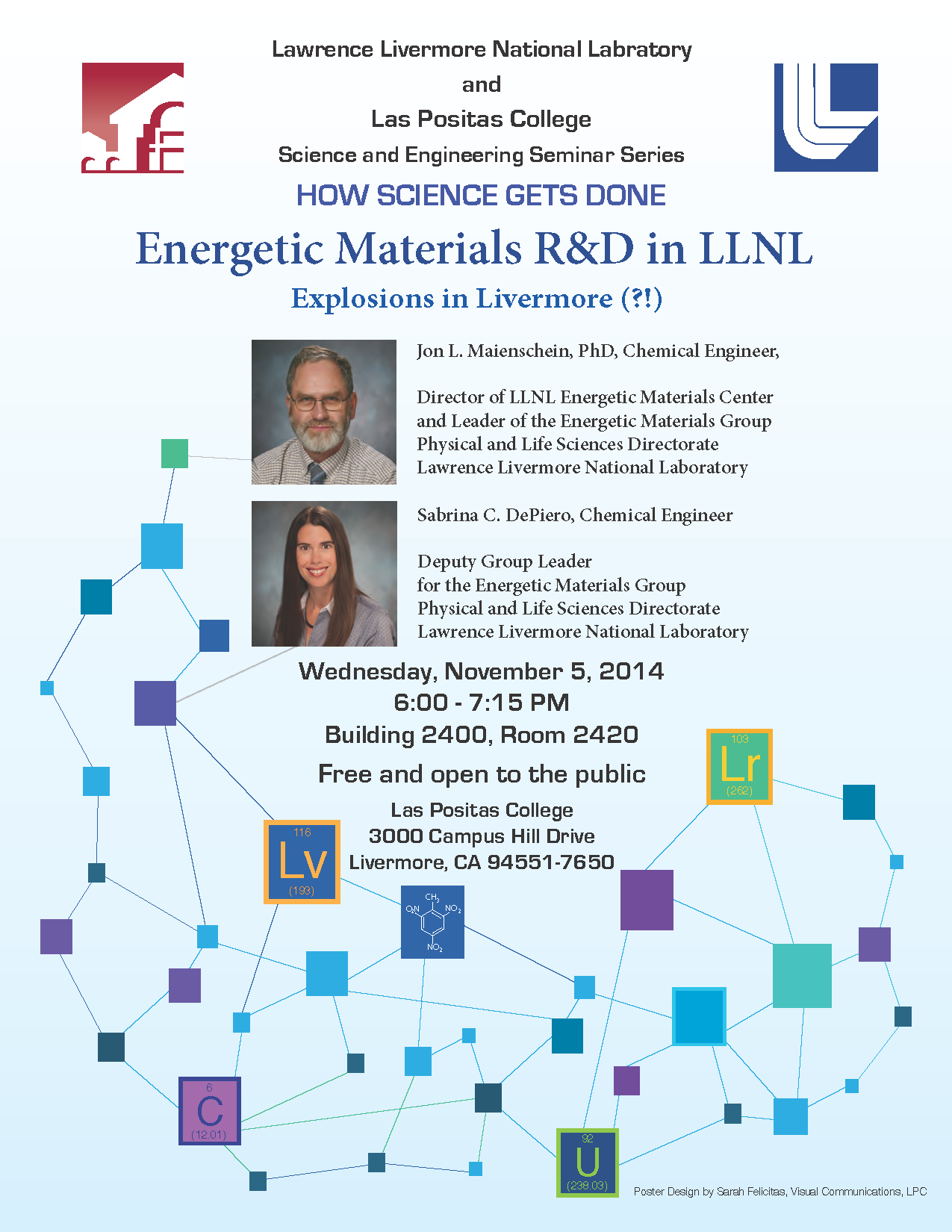
Jon L. Maienschein, PhD, Chemical Engineer
Director of LLNL Energetic Materials Center and Leader of the Energetic Materials Group
and
Sabrina C. DePiero, BS, Chemical Engineer
Deputy Group Leader for the Energetic Materials Group
Physical and Life Sciences Directorate
Lawrence Livermore National Laboratory
Date: Wednesday, November 5, 2014
Time: 6:00-7:15 pm
No Cost: Free and Open to the Public
Location: Room 2420 Lecture Hall, Building 2400, Las Positas College, Livermore, CA.
For More Information: Please contact: Nan Ho, Instructor of Biology, Las Positas College, at [email protected], Phone: 925.424.1344.
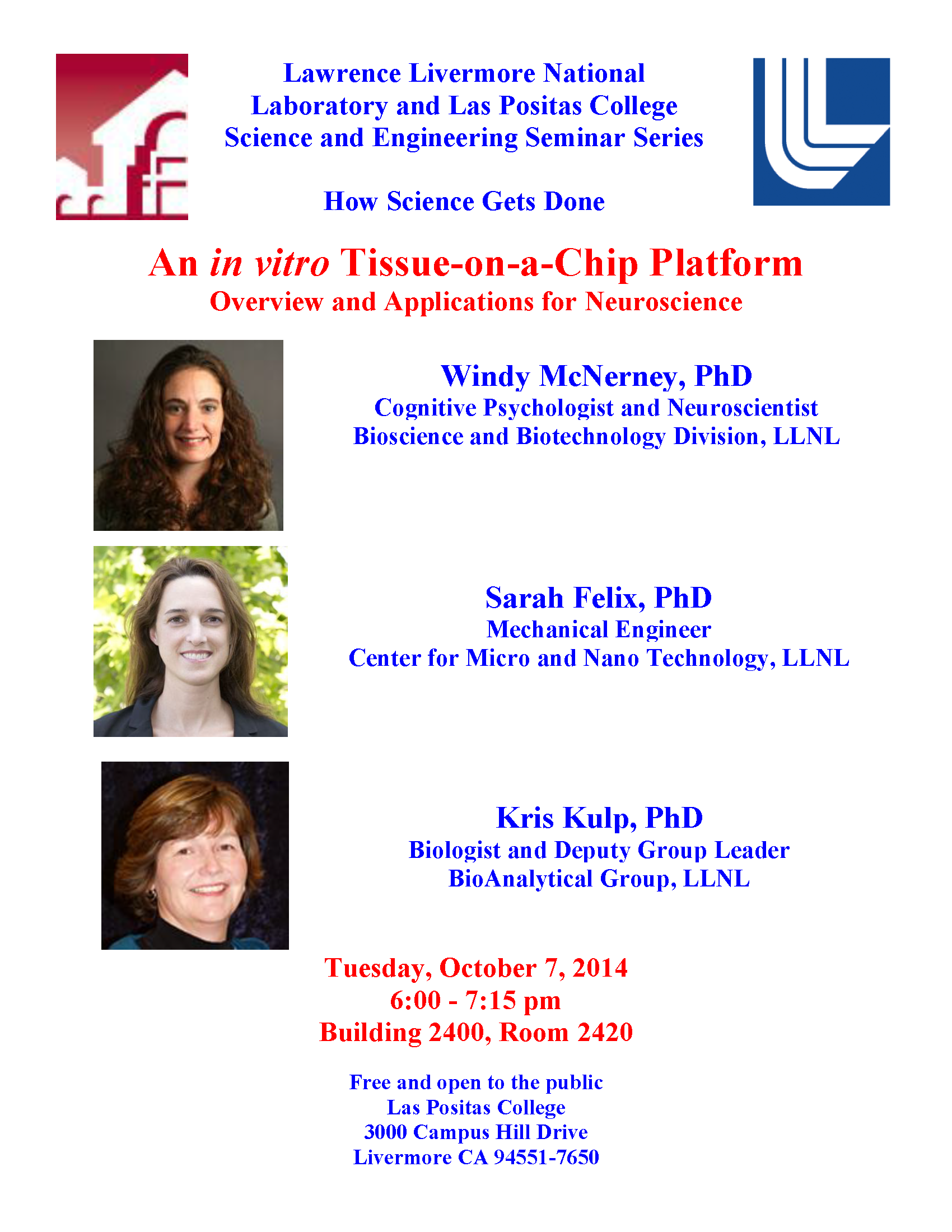
by
Windy McNerney, Ph.D., Cognitive Psychologist and Neuroscientist
Sarah Felix, Ph.D., Mechanical Engineer, Center for Micro and Nano Technology
Kris Kulp, Ph.D., Biologist, Deputy Group Leader, BioAnalytical Group
Lawrence Livermore National Laboratory
Date: Tuesday, October 7, 2014
Time: 6:00-7:15 pm
No Cost: Free and Open to the Public
Location: Room 2420 Lecture Hall, Building 2400, Las Positas College, Livermore, CA.
For More Information: Please contact: Nan Ho, Instructor of Biology, Las Positas College, at [email protected], Phone: 925.424.1344.
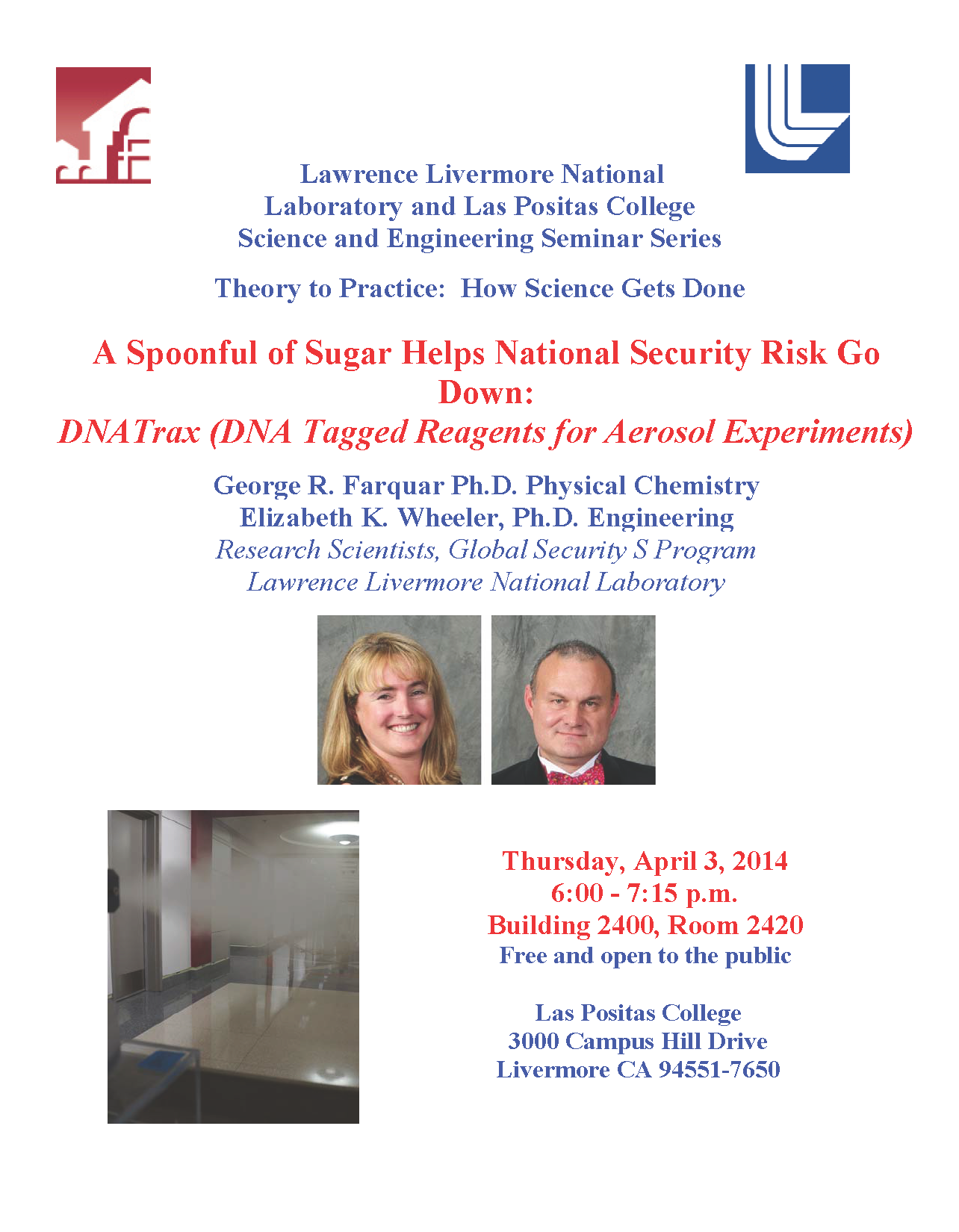
by
George R. Farquar, Ph.D., Physical Chemistry
Elizabeth K. Wheeler, Ph.D., Engineering
Research Scientists, Global Security S Program
Lawrence Livermore National Laboratory
Date: Thursday, April 3, 2014
Time: 6:00-7:15 pm
Location: Room 2420 Lecture Hall, Building 2400, Las Positas College, Livermore, CA.
For More Information: Please contact: Nan Ho, Instructor of Biology, Las Positas College, at [email protected], Phone: 925.424.1344.
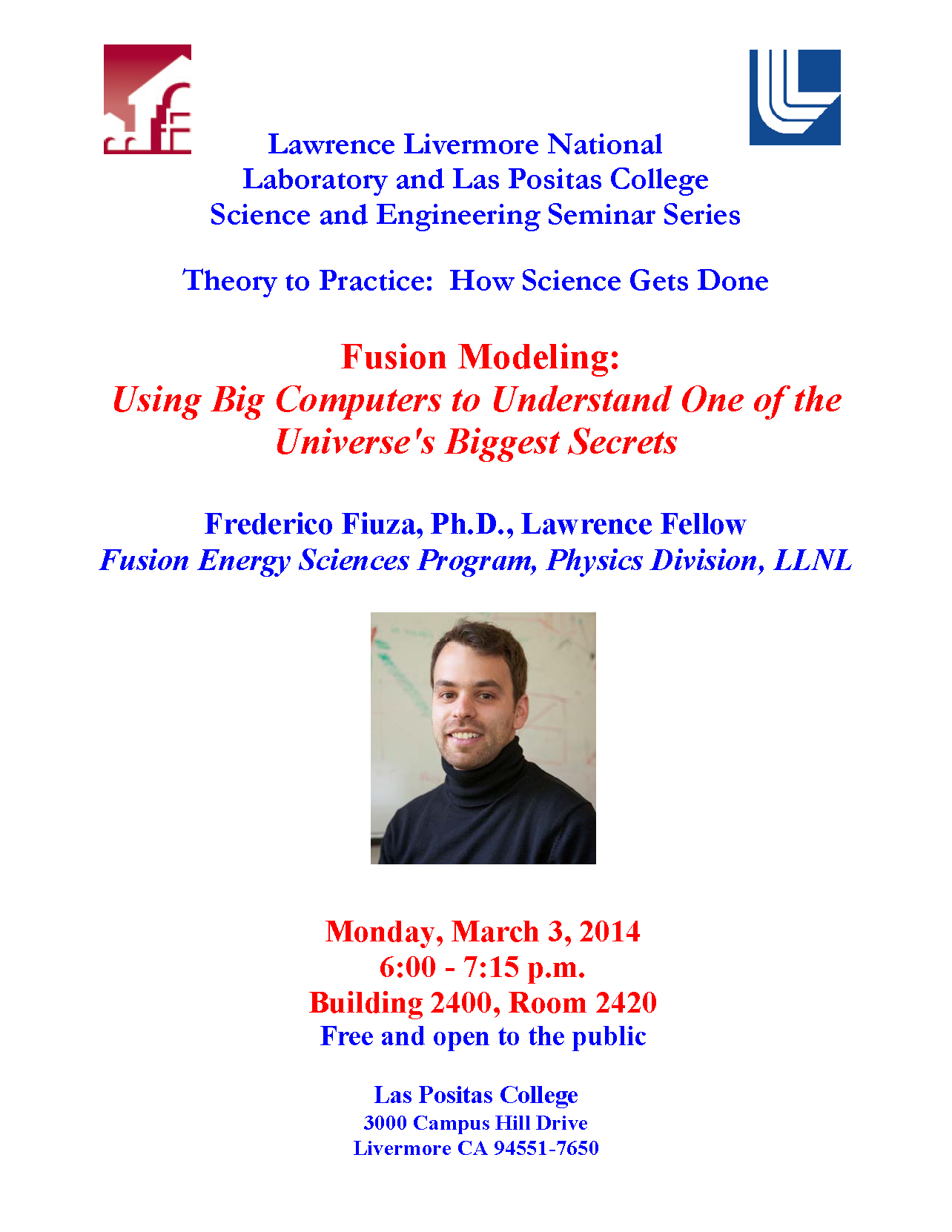
by
Frederico Fiuza, Ph.D., Lawrence Fellow
Fusion Energy Sciences Program, Physics Division
Lawrence Livermore National Laboratory
Date: Monday, March 3, 2014
Time: 6:00-7:15 pm
Location: Room 2420, Las Positas College (Parking: $2 or Semester Permit)
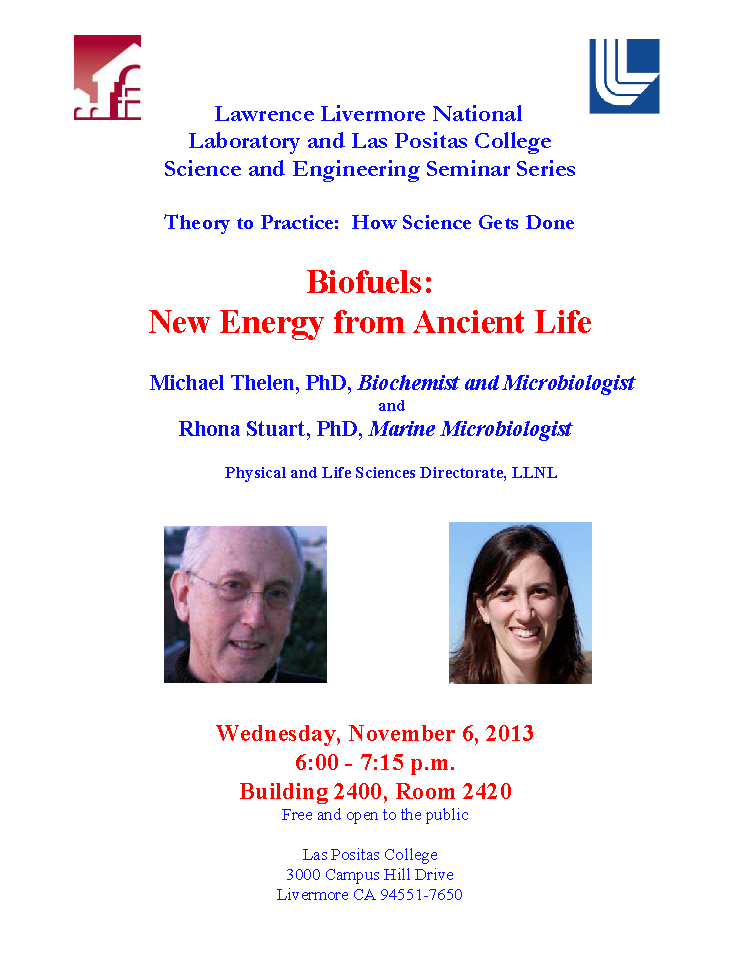
by
Michael Thelen, PhD, Biochemist and Microbiologist, LLNL
Rhona Stuart, PhD, Marine Microbiologist, LLNL Physical and Life Sciences
Directorate
Date: Wednesday, November 6, 2013
Time: 6:00-7:15 pm
Location: Room 2420, Las Positas College (Parking: $2 or Semester Permit)
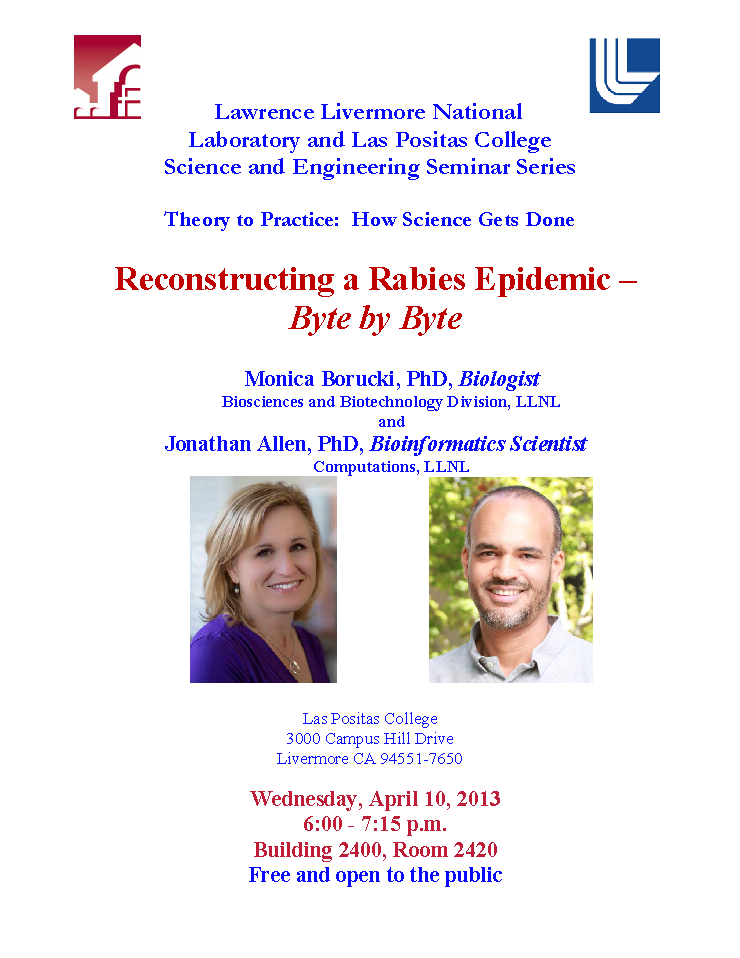
by
Monica Borucki, PhD: Biologist, Biosciences and Biotechnology Division, LLNL
Jonathan Allen, PhD: Bioinformatics Scientist, Computations, LLNL
Date: Wednesday, April 10, 2013
Time: 6:00-7:15 pm
Location: Room 2420, Las Positas College (Parking: $2 or Semester Permit)
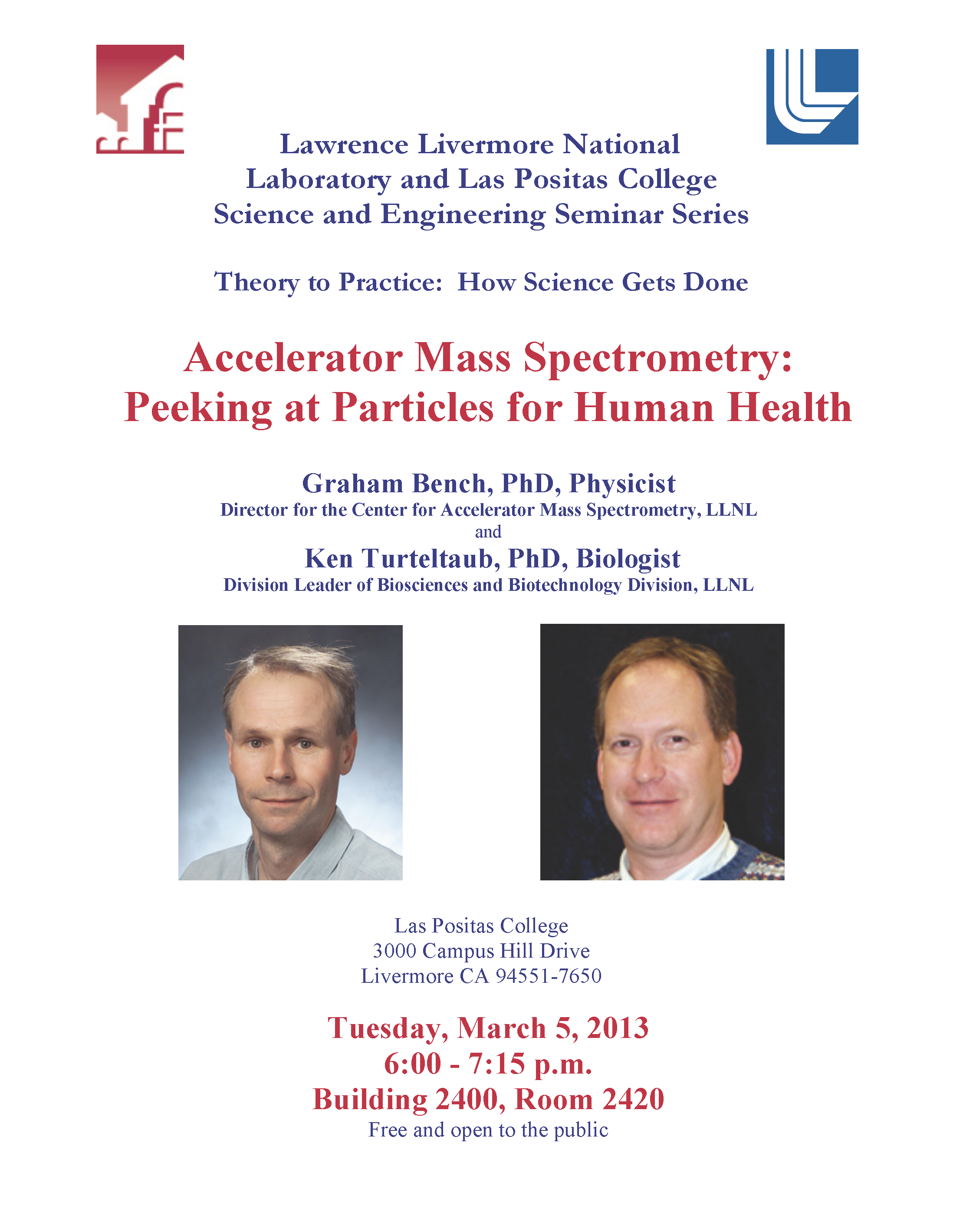
by
Graham Bench, PhD, Physicist, Director for the Center for Accelerator Mass Spectrometry, LLNL
Ken Turteltaub, PhD, Biologist, Division Leader of Biosciences and Biotechnology Division, LLNL
Date: Tuesday, March 5, 2013
Time: 6:00-7:15 pm
Location: Room 2420, Las Positas College (Parking: $2 or Semester Permit)
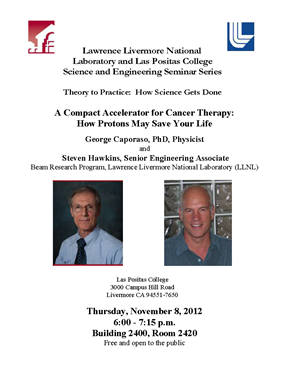
by
George Caporaso, Ph.D., Physicist, Beam Research Program, LLNL
Steven Hawkins, Senior Engineering Associate, Beam Research Program, LLNL
Date: Thursday, November 8, 2012
Time: 6:00-7:15 pm
Location: Room 2420, Las Positas College (Parking: $2 or Semester Permit)
The 2011-2012 Second Annual Lawrence Livermore National Laboratory / Las Positas College Science and Engineering Seminar series began on Oct 3, 2011. This series provided LLNL scientists and engineers a forum to share a broad range of basic and applied research with LPC faculty and students. The presentations were interdisciplinary in nature and focused on how science is applied to solve problems from theory to practice. The seminars were targeted to run about 45 minutes, with another 30 minutes allocated for questions and answers.
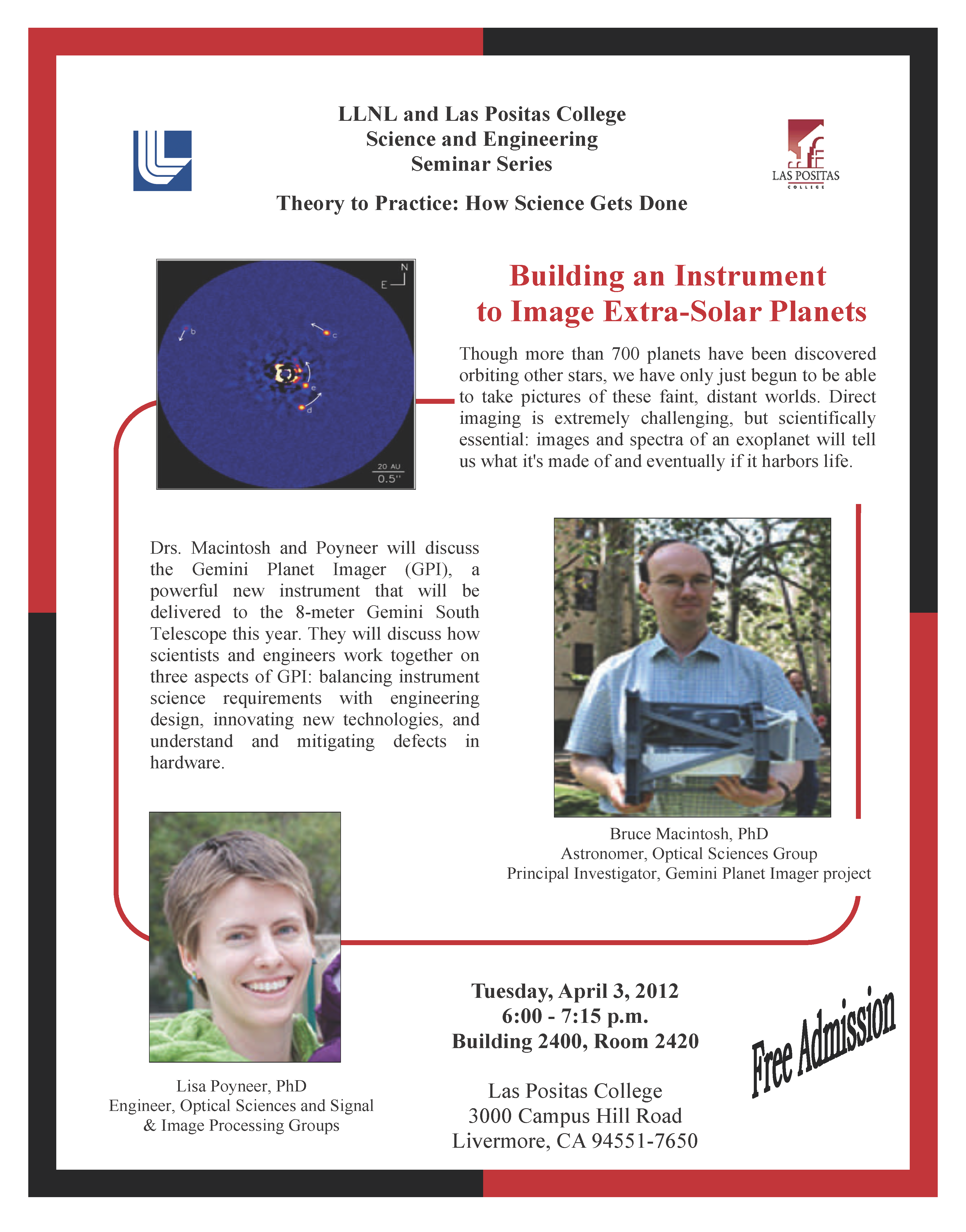
by
Lisa Poyneer, Ph.D., Engineer, Optical Sciences and Signal & Image Processing Groups, Lawrence Livermore National Laboratory
Bruce Macintosh, Ph.D., Astronomer, Optical Sciences Group, Principal Investigator, Gemini Plant Imager Project, Lawrence Livermore National Laboratory
Though more than 700 planets have been discovered orbiting other stars, we have only just begun to be able to take pictures of these faint, distant worlds. Direct imaging is extremely challenging, but scientifically essential: images and spectra of an exoplanet will tell us what it's made of and, eventually, if it harbors life.
Drs. Macintosh and Poyneer will discuss the Gemini Planet Imager (GPI), a powerful new instrument that will be delivered to the 8-meter Gemini South Telescope this year. They will discuss how scientists and engineers work together on three aspects of GPI: balancing instrument science requirements with engineering design, innovating new technologies, and understanding and mitigating defects in hardware.
Location: Room 2420, Las Positas College (Parking: $2 or Semester Permit)
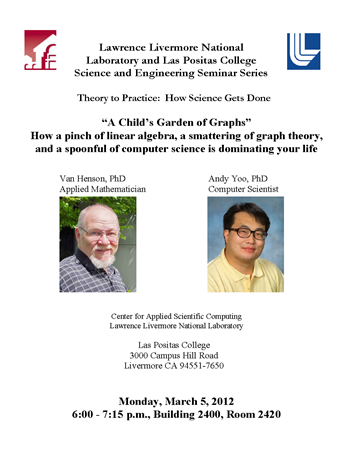
by
Van Emden Henson, PhD, Applied Mathematician
Andy Yoo, PhD, Computer Scientist, Center for Applied Scientific Computing, LLNL
Date: Monday, March 5, 2012
Time: 6:00 PM to 7:15 PM
Location: Room 2420, Las Positas College (Parking: $2 or Semester Permit)
How does Netflix (or Amazon) recommend the movies (or products) you may like? How do Google, AltaVista, or Bing assemble their lists of results? How does Mapquest figure out the best route from here to there? How does Expedia find an airline itinerary? How do Facebook or LinkedIn find people you may know? How do dating sites propose possible matches? How do banks catch potentially fraudulent activities? These, and many, many more, are examples of graphs in action. While some of the graph algorithms are subtle and complex, a surprising number are remarkably simple. Many can best be understood and implemented with the tools of linear algebra, relying heavily on the matrix-vector product, matrix factorizations, and spectral analysis.
But the modern world is also the world of exponential growth of information, and many of the graphs behind these applications are rapidly growing to extraordinary size. How do we deal with graphs having tens or hundreds of billions of vertices? How can we deal with information at enormous scales?
Where the mathematician and the applications scientist devise the algorithms to organize, mine, or employ the information, it falls to the computer scientists to create the architectures, hardware, software environments, and implementations making the computations possible. Just as the information is evolving, so are the approaches to computing and the architectures of the machines.
In this talk, Van Emden Henson will describe some of the graph-based problems that have become ubiquitous in today’s world, and the mathematical tools used to address them, and Andy Yoo will describe the challenges and approaches to realizing these methods on the most modern computational engines.
by
Holly Franz, PhD, Biomedical Scientist, Deputy Program Director for Biosecurity, Office of Strategic Outcomes, LLNL
Reg Beer, PhD, Mechanical Engineer, Principal Investigator and Associate Program Leader, National Security Engineering Division, Center for Micro- and Nanotechnologies, LLNL
Date: Tuesday, November 8, 2011
Time: 6:00 to 7:15 PM
Location: Room 2420, Las Positas College (Parking: $2 or Semester Permit)
Protecting public health from the next pandemic or ensuring that you get the best care possible in the Emergency Room or other clinical setting requires fast and accurate diagnosis of infectious disease. Effective detection technologies must be fast, sensitive, and specific to the precise cause of the patient's sickness. LLNL is working towards extremely rapid medical diagnostics that determine the exact bacteria or virus causing infection by recognizing the organism's nucleic acid (DNA or RNA) fingerprint. We will discuss trends and specific technologies to meet this critical need in a much faster time than previously possible.
by
Sat Pannu, PhD, Section Leader for Center for Micro and Nano-Technology
Kedar Shah, M.S.
Heeral Sheth, M.S.
Vanessa Tolosa, Ph.D.
Angela Tooker, Ph.D.
Lawrence Livermore National Laboratory
Date: Monday, October 3, 2011
Time: 6 to 7:15 pm
Location: Main Stage Theater - Mertes Center for the Arts, Bldg. 4000 Las Positas College, Livermore, CA (Parking: $2 or Semester Permit)
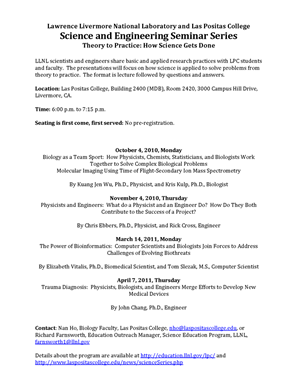
State of health monitoring in traumatic and harsh environments: Engineers and Health care providers Merge Efforts to Develop New Medical Devices
by
John Chang, PhD, Electrical Engineer
Christine Paulson, M.S., Electrical Engineer, Engineering Directorate, LLNL
Date: Thursday, April 7, 2011
Time: 6 to 7:15 pm
Location: Room 2420, Las Positas College (Parking: $2 or Semester Permit)
Advancements in miniaturized electronic circuitry and Micropower Ultrawideband Impulse Radar (MUIR) technology have allowed for the creation of a compact, non-invasive device that may permit never before possible portable state of health diagnosis and monitoring of life threatening traumatic injuries. MUIR generates electromagnetic pulses with extremely short duration and at power levels much less than that emitted by cell phones. The MUIR electromagnetic signals penetrate relatively well into the human body. These electromagnetic signals interact differently with different body tissue types over a broad spectral range, and can indicate certain conditions of tissues and organs. The MUIR technology can be built into small, portable, and handheld systems. Such capabilities can be used in the field in harsh environments to determine immediate life threatening injuries and monitor the state of health until definitive medical intervention becomes available.
We will describe LLNL's efforts in applying this technology to different fields of medicine and healthcare. We will describe the technology, the partnership required to pursue medical device development, medical studies, and field experiences.

Computer Scientists and Biologists Join Forces to Address Challenges of Evolving Biothreats
by
Elizabeth Vitalis, Ph.D., Biomedical Scientist
Tom Slezak, M.S., Computer Scientist
Date: Monday, March 14, 2011
Location: Room 2420, Las Positas College (Parking: $2 or Semester Permit)
Physicists and Engineers: What does a Physicist and an Engineer do? How do they both contribute to the success of a project?
by
Chris Ebbers, Ph.D., Physicist
Rick Cross, Engineer
Date: Thursday, November 4, 2010
Time: 6 to 7:15 pm
Location: Room 2420, Las Positas College (Parking: $2 or Semester Permit)

Molecular Imaging of Cells and Tissues Using Time of Flight - Image of Kris Culp and Kuang Jen J. WuSecondary Ion Mass Spectrometry: Why Physicists, Chemists, Statisticians and Biologists are Needed to Solve Hard Biological Problems
by
Kris Kulp, Biologist
Kuang Jen J. Wu, Physicist
Seminar Abstract
Date: October 4, 2010
Time: 6:00 p.m.
Location: Room 2420, Las Positas College (Parking: $2 or Semester Permit)